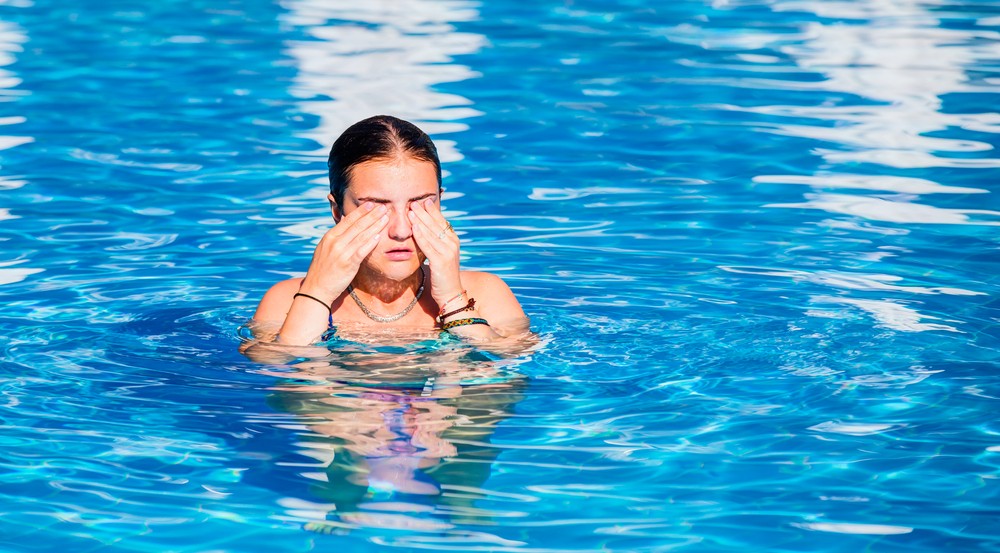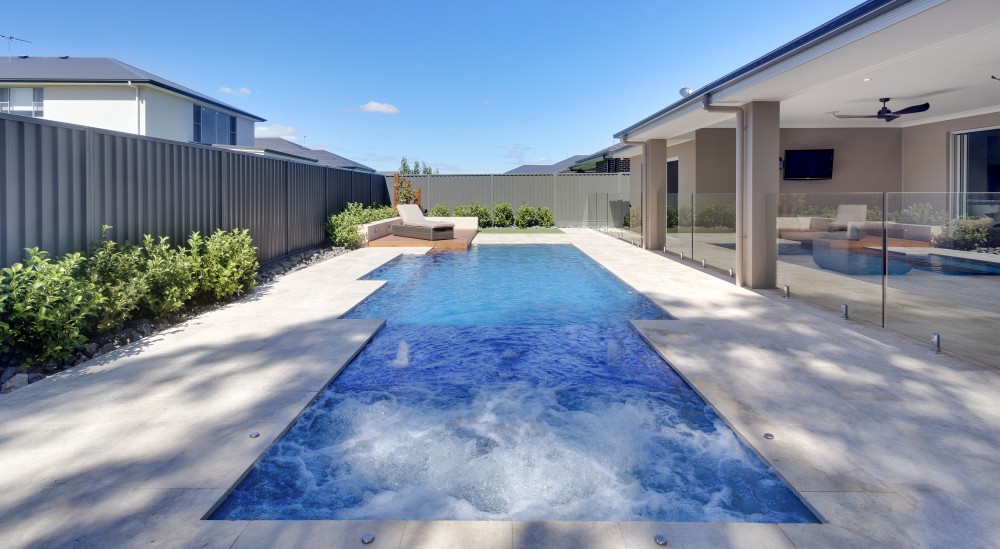Understanding how pool chlorine works can be a challenge, but it’s one of the most important pool chemicals you have at your disposal. We’ll teach you what chlorine is, how to lower chlorine in your pool, what happens if you have too much chlorine in your pool, and more below.
Defining Chlorine
Chlorine sanitises your pool water, and you can buy it in liquid, tablet, or powder form. It can help remove viruses, bacteria, body oils, dirt, waste products, and debris from your pool while preventing algae growth and bloom.
How Chlorine Works in Your Pool
Chlorine turns into hydrochloric acid when it gets into your pool that disables bacteria, viruses, and any other microscopic organisms lurking in the water. Combined chlorine is called chloramine. Generally speaking, the dose you use is safe for people. But, if you get too much chlorine in your pool, it can cause swimmer’s eye and irritate your skin. You’ll have a stinging sensation with mild irritation that fades after you exit the water.
However, chlorine doesn’t cause this irritation; chloramides do. A chloramide is a leftover piece of chlorine that has killed whatever contaminant was in your water. The filter system is usually responsible for getting rid of chloramides in the water, or you can burn it away by shocking your pool. People can incorrectly blame chlorine for this irritation when it’s usually a problem with the pool’s circulation.
Chlorine works best when your pH falls into the correct range, so you want to test your other chemicals when you add chlorine. The UV rays from the sun can speed up the process, so you’ll use more chlorine if you live in a sunny location like Melbourne or other parts of Victoria.
The Different Forms Chlorine Comes In
You can get your chlorine in unstabilised and stabilised forms. Chlorine comes in powder, liquid, or tablets, and we’ll outline the two types below.
- Unstabilised – This form doesn’t have any cyanuric acid in it, and the sun will burn through it a lot quicker. This is why most people use it in indoor pools. If you want to use it outdoors, you either have to add cyanuric acid to the water or make sure your pool is in a shaded location. You can use it to shock your pool overnight because the sun will burn it off quickly in the morning.
- Stabilised – Stabilised chlorine comes with cyanuric acid mixed in that allows it to survive outside in sunny spots without burning off or breaking down. However, adding it can cause your cyanuric acid levels to spike, so you want to test it or it’ll cause your water to get cloudy. If it spikes, add more chlorine.
Pool Shock
When the microorganisms in your pool combine with the chlorine, chloramines can appear. Adding more chlorine to the water makes the levels of chloramines go up. This can cause eye or skin irritation, reduce how effective the sanitation process is, and release a strong smell.
You have to shock your pool to get rid of the chloramines, and you have to add at least 10 times the amount of chlorine to reach a breaking point. The chlorine will break down the chloramine due to oxidation. If you stop before you add enough chlorine, you can make the chloramine levels rise even higher.
When this happens, you can end up with swimmer’s eye. This is a condition where the chemicals in your pool wash away your eye’s protective barrier. In turn, your eyes can experience irritation, burning, itching, and swelling. You’ll have to flush your eyes and apply a cold compress to help treat it. Skin irritation is also common, and your skin will feel itchy and dry. It’ll get worse each time you go into the water.
Chlorine Alternatives
If you don’t like the idea of adding chlorine to your pool, there are options available. Some people purposely look for alternatives because they don’t want to experience skin irritation or itchy eyes. The most popular chlorine alternatives are below.
- Biguanide – You buy this alternative in liquid form — it’s a sanitiser with a peroxide base. Your water will have a much softer feel compared to water with chlorine. It doesn’t work well on killing organic matter, but it can kill bacteria. It’s more expensive, and you’ll have to routinely shock your pool using hydrogen peroxide.
- Bromine – Bromine is similar to chlorine, and it usually comes in tablet form. It doesn’t have the sharp scent, and it can be more effective when it comes to sanitising your water because its levels don’t fluctuate as much. However, it’s very expensive, and it’s unstabilised. The UV rays from the sun will burn through it much faster. Bromine is popular in indoor pools and hot tubs.
- Salt – Saltwater pools make the pool water flow through a saltwater generator to turn the salt content into chlorine. It removes the need to purchase chlorine, and this makes it cheaper. It’s also less labour-intensive, but it does have a higher cost upfront.
- Minerals – This releases silver or copper ions into the pool using an ioniser. It can fight viruses, algae, and bacteria, but you have to replace your filter cartridges once a year. It’s a slightly slower system, and works best with a small dose of chlorine added in.
Testing and Balancing Chlorine Swimming Pools
Your free chlorine levels should sit between 1 and 3 parts per million (ppm) to hit the chlorine residual rate. Several factors influence whether or not you’re successful at keeping them in this range. The pH should stay between 7.2 and 7.8, and pool debris like body oil and lotion can throw it off.
Your pool’s alkalinity is important, too. This chemical acts like a buffer to prevent the pH from going up or down, and the ideal number is 125 ppm. However, you should be OK if your alkalinity ranges between 100 and 150 ppm.
Once you find the best balance for your pool chemicals, testing them at least once a week is key. Pool test strips are popular but they’re not 100 percent accurate. A pool test kit will give you better results for all of your chemicals, including your pool chlorine. The ideal levels are as follows:
- pH – 7.2 to 7.8
- Bromine – 5 to 3 ppm
- Cyanuric Acid – 100 ppm or lower
- Calcium Hardness – 175 to 225 ppm (200 to 275 ppm for concrete or plaster pools)
- Alkalinity – 100 to 150 ppm
- Biguanide – 30 to 50 ppm
Using Pool Chlorine Successfully
- Store your chlorine in a cool and dry place — and out of reach of pets and kids.
- Always take a few minutes to read the manufacturer’s instructions and make sure you understand them so you don’t accidentally overload your pool.
- Never mix your pool chemicals before you add them to your water. Instead, add them one at a time.
- Avoid breathing in any fumes or vapours because they can be strong.
- Only buy the chemicals you’ll use in a single season because their effectiveness goes down with age.
Potential Negative Effects of Chlorine in Your Pool
If you let your chlorine fluctuate and don’t balance your chemicals, it can cause problems for your pool. The chemicals could attack and break down your pool’s siding. If you have a vinyl pool, this is exactly why you need to replace the liner every few years.
However, there are much more durable pool options available like fibreglass ones. Compass Pools Melbourne installs fibreglass pools built by Compass Pools Australia. They’re very durable, and the smooth siding makes it difficult for algae and bacteria to grow and thrive. In turn, you’ll spend less time fiddling with your chemical levels or getting rid of algae. There is also a saltwater chlorinator available that helps lower your chlorine levels.
If you want to keep your pool healthy and clean, consider the Vantage In-Floor Cleaning System. It circulates the water and gets rid of debris that could throw your pH and chemical levels off.
Visit Compass Pools Melbourne Today
A fibreglass pool is a wonderful option if you want to get a durable pool and save money on pool chemicals. If you’d like to know more or see which pools are available, visit Compass Pools Melbourne today. We’re ready to help in any way we can.










Whoa, this is such a thorough guide on chlorine! This post truly lays out how to properly maintain your pool; I’ve always been a little puzzled about it. I appreciate the clarity.